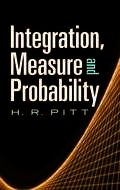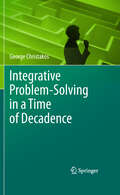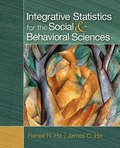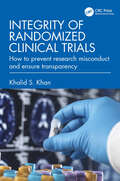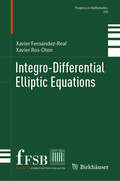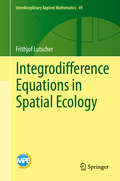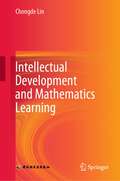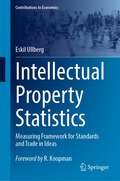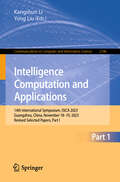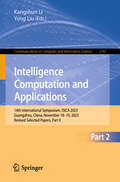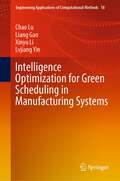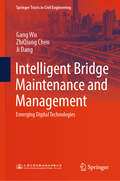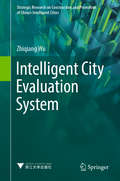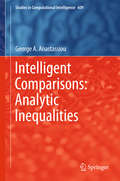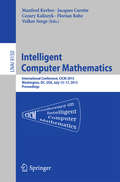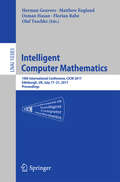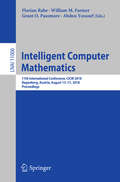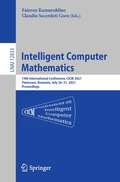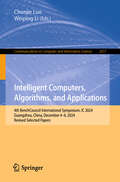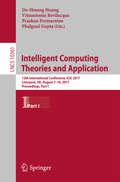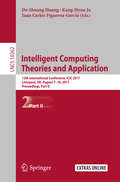- Table View
- List View
Integration, Measure and Probability
by H. R. PittThis text provides undergraduate mathematics students with an introduction to the modern theory of probability as well as the roots of the theory's mathematical ideas and techniques. Centered around the concept of measure and integration, the work is applicable to other branches of analysis and explores more specialized topics, including convergence theorems and random sequences and functions. 1963 edition.
Integrative Problem-Solving in a Time of Decadence
by George ChristakosPresents a unique study of Integrative Problem-Solving (IPS). The consideration of 'Decadence' is essential in the scientific study of environmental and other problems and their rigorous solution, because the broad context within which the problems emerge can affect their solution. Stochastic reasoning underlines the conceptual and methodological framework of IPS, and its formulation has a mathematical life of its own that accounts for the multidisciplinarity of real world problems, the multisourced uncertainties characterizing their solution, and the different thinking modes of the people involved. Only by interpolating between the full range of disciplines (including stochastic mathematics, physical science, neuropsychology, philosophy, and sociology) and the associated thinking modes can scientists arrive at a satisfactory account of problem-solving, and be able to distinguish between a technically complete problem-solution, and a solution that has social impact.
Integrative Statistics for the Social and Behavioral Sciences
by Renee R. Ha James C. HaDesigned to engage students and lower their "fear factor", Integrative Statistics for the Social and Behavioral Sciences is a concise, user-friendly text that prepares students to use statistics in the real world. Providing depth and breadth of statistical tests, the text focuses on choosing the appropriate statistical analysis, and shows how to interpret the output and present the results.
Integrity of Randomized Clinical Trials: How to prevent research misconduct and ensure transparency
by Khalid S. KhanToday, scientists are expected to be more accountable and transparent than at any other time in history. Globally, the pursuit of knowledge creation enjoys a place of distinction, and the public expects to reap considerable benefits from the innovative contributions made by researchers. It is, therefore, more important than ever that ethics, transparency, and professionalism explicitly guide research integrity.Despite the clear importance of acquiring a fundamental understanding of clinical trials in the context of health research and innovation, medical training generally fails to cover clinical trial integrity in its curriculum, including it neither at the undergraduate nor at the postgraduate levels. This new book provides a curriculum to address this gap, offering best practice guidelines to improve the quality, openness, and trustworthiness of clinical trials and filling a current void in the market.Key Features: The first book on clinical trial integrity Provides clear guidance on how to ensure probity in peer review, appraisal of trials, and investigation of complaints concerning misconduct in clinical trials Trains and supports researchers globally on how to undertake trials with integrity Ensures that the increasing demand for public documentation of all aspects throughout the lifecycle of a clinical trial can be met This book is essential reading for master and doctoral students undertaking courses in clinical trials, epidemiology, and medical statistics and an invaluable reference for medical journal editors and peer reviewers, clinicians who recruit patients into trials, pharmaceutical industry professionals, patient and public representatives who engage in clinical trials, systematic reviewers, guideline writers, and funders and regulators of clinical trials.
Integro-Differential Elliptic Equations (Progress in Mathematics #350)
by Xavier Ros-Oton Xavier Fernández-RealThis monograph offers a self-contained introduction to the regularity theory for integro-differential elliptic equations, mostly developed in the 21st century. This class of equations finds relevance in fields such as analysis, probability theory, mathematical physics, and in several contexts in the applied sciences. The work gives a detailed presentation of all the necessary techniques, with a primary focus on the main ideas rather than on proving all the results in their greatest generality. The basic building blocks are presented first, with the study of the square root of the Laplacian, and weak solutions to linear equations. Subsequently, the theory of viscosity solutions to nonlinear equations is developed, and proofs are provided for the main known results in this context. The analysis finishes with the investigation of obstacle problems for integro-differential operators and establishes the regularity of solutions and free boundaries. A distinctive feature of this work lies in its presentation of nearly all covered material in a monographic format for the first time, and several proofs streamline, and often simplify, those in the original papers. Furthermore, various open problems are listed throughout the chapters.
Integrodifference Equations in Spatial Ecology (Interdisciplinary Applied Mathematics #49)
by Frithjof LutscherThis book is the first thorough introduction to and comprehensive treatment of the theory and applications of integrodifference equations in spatial ecology. Integrodifference equations are discrete-time continuous-space dynamical systems describing the spatio-temporal dynamics of one or more populations. The book contains step-by-step model construction, explicitly solvable models, abstract theory and numerical recipes for integrodifference equations. The theory in the book is motivated and illustrated by many examples from conservation biology, biological invasions, pattern formation and other areas. In this way, the book conveys the more general message that bringing mathematical approaches and ecological questions together can generate novel insights into applications and fruitful challenges that spur future theoretical developments. The book is suitable for graduate students and experienced researchers in mathematical ecology alike.
Intellectual Development and Mathematics Learning
by Chongde LinThis book introduces the outcomes of author’s 40 years of research, especially the theory of “the Triangular Pyramid Structure of Thinking” that he independently proposed, and the application of his development theory in the field of mathematics education. The book firstly explains the substantial character of intelligence, the development law of intelligence, and the relationship between intelligence development and creativity cultivation. Secondly, it discusses the structure of mathematical thinking of children and adolescents from 0 to 18 years old, and the methods of developing students’ thinking ability and the quality of intelligence through arithmetic learning. In the end, this book also demonstrates the characteristics of the development of mathematical thinking ability of children at age 0-6, elementary school students, and secondary school students, and the related latest research in this field. Based on the theory of “the Triangular Pyramid Structure of Thinking”, a number of examples are given to illustrate how the theory of intelligence development can be used in mathematics teaching to promote the development of students’ thinking abilities and to improve the quality of teaching.This book covers various areas including psychology, mathematics, and education. It has a great reference value for scholars in the field of psychology to study the theory of intelligence and the structure of thinking, providing guidance for parents and mathematics teachers to promote children’s quality of intelligence and mathematical thinking abilities, and to enhance their mathematics learning effects. In addition, it provides examples for psychological research to serve specific subject teaching in elementary and secondary schools.
Intellectual Property Statistics: Measuring Framework for Standards and Trade in Ideas (Contributions to Economics)
by Eskil UllbergPatents and other intellectual property (IP) rights are increasingly part of cross-border trade in their own rights. Patent transfers and patent licensing between inventors, investors and innovators create new business strategies of cooperation in the creation of new technology – increasing the productivity in the stock of technology assets – and efficient “distribution” of these rights. The rights bundles are then used – also increasingly – in products and services being traded cross-border, furthering economic efficiency created by this cooperative strategy. Today’s international trade statistics, however, lack statistics explicitly on trade flows from ideas, based on IP rights. This book offers an idea based statistical framework to measure IP, (i.e., increasingly depends on trade in ideas) and explores ways to introduce the framework into international standards. Specifically, it offers a theory of value to measure the flows from IP and an asset view of IP to deal with allocation of resources and who owns these rights. This is then contrasted with the current way IP is treated and a “gap analysis” is used to identify what needs to change in the standards. This new framework can help develop theories, policies, practices and inform the decisions needed to better leverage the human capital formation of inventors everywhere. Praise for Intellectual Property Statistics… “In this book, Prof. Ullberg has undertaken a Herculean task – to lay out a paradigm for the collection of IP Statistics to ensure that the … market of trade in ideas has the information and data necessary to function well. [the] volume should be viewed as a starting point, a work in progress, but an important one that could very well influence the development of this important set of data on trade in ideas. At a time when global issues … require both new ideas and the spread of those ideas widely to help ensure both economic growth and continued global economic convergence data that helps us monitor and evaluate what is happening in trade in ideas will be extremely valuable.” – Robert Koopman, American University, Washington, DC, USA and Former Chief Economist, World Trade Organization, Geneva, Switzerland
Intelligence Computation and Applications: 14th International Symposium, ISICA 2023, Guangzhou, China, November 18–19, 2023, Revised Selected Papers, Part I (Communications in Computer and Information Science #2146)
by Yong Liu Kangshun LiThis two-volume set, CCIS 2146 and CCIS 2147, constitutes the refereed proceedings of the 14th International Symposium on Intelligence Computation and Applications, ISICA 2023, held in Guangzhou, China, during November 18–19, 2023. The 82 full papers included in these proceedings were carefully reviewed and selected from 178 submissions. The papers presented in these two volumes are organized in the following topical sections: Part I: Frontiers of evolutionary Intelligent Optimization Algorithms; Exploration of computer vision; Machine learning and its applications. Part II: Machine Learning and its applications; Big data analysis and Information security; Intelligent application of computer.
Intelligence Computation and Applications: 14th International Symposium, ISICA 2023, Guangzhou, China, November 18–19, 2023, Revised Selected Papers, Part II (Communications in Computer and Information Science #2147)
by Yong Liu Kangshun LiThis two-volume set, CCIS 2146 and CCIS 2147, constitutes the refereed proceedings of the 14th International Symposium on Intelligence Computation and Applications, ISICA 2023, held in Guangzhou, China, during November 18–19, 2023. The 82 full papers included in these proceedings were carefully reviewed and selected from 178 submissions. The papers presented in these two volumes are organized in the following topical sections: Part I: Frontiers of evolutionary Intelligent Optimization Algorithms; Exploration of computer vision; Machine learning and its applications. Part II: Machine Learning and its applications; Big data analysis and Information security; Intelligent application of computer.
Intelligence Optimization for Green Scheduling in Manufacturing Systems (Engineering Applications of Computational Methods #18)
by Liang Gao Xinyu Li Chao Lu Lvjiang YinThis book investigates in detail production scheduling technology in different kinds of shop environment to achieve sustainability manufacturing. Studies on shop scheduling have attracted engineers and scientists from various disciplines, such as electrical, mechanical, automation, computer, and industrial engineering. Pursuing a holistic approach, the book establishes a fundamental framework for this topic, while emphasizing the importance of intelligent optimization and the significant influence of production scheduling in the manufacturing systems. The book is intended for undergraduate and graduate students who are interested in intelligent optimization technology, shop scheduling, and green manufacturing systems or other scheduling applications.
Intelligent Bridge Maintenance and Management: Emerging Digital Technologies (Springer Tracts in Civil Engineering)
by Gang Wu Ji Dang ZhiQiang ChenThis book provides a timely introduction to the methodology of Intelligent Bridge Maintenance and Management (IBM&M) and a comprehensive synthesis of emerging digital technologies for realizing IBM&M. The authors, who carry research, teaching, and consulting experience in the USA, Japan, and China, present the background, principles, methods, and application examples of essential IBM&M solutions in eight dedicated chapters. The digital technologies covered in this book include: • Artificial intelligence, big data, machine learning, computer vision. • Data fusion, 3D building information, digital twin modeling, virtual and augmented reality. • Internet of things sensors, robotics including unmanned vehicles. The book targets the audience in the broader Bridge Engineering community, including academic researchers, students, bridge owners, and technology providers.
Intelligent City Evaluation System (Strategic Research on Construction and Promotion of China's Intelligent Cities)
by Zhiqiang WuThis book assesses various intelligent-city evaluation systems around the globe, and subsequently combines that assessment with local-government and enterprise practices to create an evaluation index system for quantifying the Intelligent City concept. In addition, the book provides the results of the CityIQ indicator ranking of intelligent cities in China and worldwide, a system that focuses on three of the most crucial aspects of urban development: the development environment, future trends, and construction and operation. After data sorting, calculation and dimensionless treatment, a score system ranging from 0 to 100 is created for ranking and analyzing cities. Providing unique strategies for promoting an intelligent city evaluation system, the book offers a valuable reference guide for intelligent-city decision-makers, as well as leaders in public urban economy, social welfare and environmental authorities.
Intelligent Comparisons: Analytic Inequalities
by George A. AnastassiouThis monograph presents recent and original work of the author on inequalities in real, functional and fractional analysis. The chapters are self-contained and can be read independently, they include an extensive list of references per chapter. The book's results are expected to find applications in many areas of applied and pure mathematics, especially in ordinary and partial differential equations and fractional differential equations. As such this monograph is suitable for researchers, graduate students, and seminars of the above subjects, as well as Science and Engineering University libraries.
Intelligent Computer Mathematics
by Manfred Kerber Jacques Carette Cezary Kaliszyk Florian Rabe Volker SorgeThis book constitutes the refereed proceedings of the International Conference on Intelligent Computer Mathematics, CICM 2015, held in Washington, DC, USA, in July 2015. The 16 full papers and 9 short papers presented together with two invited talks plus one abstract were carefully reviewed and selected from a total of 43 submissions. The papers are organized in topical sections following the tracks of the conference: Invited Talks; Calculemus; Digital Mathematics Libraries; Mathematical Knowledge Management; Projects and Surveys; Systems and Data.
Intelligent Computer Mathematics
by Herman Geuvers Florian Rabe Matthew England Osman Hasan Olaf TeschkeThis book constitutes the joint refereed proceedings of three international events, namely the 18th Symposium on the Integration of Symbolic Computation and Mechanized Reasoning, Calculemus 2011, the 10th International Conference on Mathematical Knowledge Management, MKM 2011, and a new track on Systems and Projects descriptions that span both the Calculemus and MKM topics, all held in Bertinoro, Italy, in July 2011. All 51 submissions passed through a rigorous review process. A total of 15 papers were submitted to Calculemus, of which 9 were accepted. Systems and Projects track 2011 there have been 12 papers selected out of 14 submissions while MKM 2011 received 22 submissions, of which 9 were accepted for presentation and publication. The events focused on the use of AI techniques within symbolic computation and the application of symbolic computation to AI problem solving; the combination of computer algebra systems and automated deduction systems; and mathematical knowledge management, respectively.
Intelligent Computer Mathematics: 11th International Conference, CICM 2018, Hagenberg, Austria, August 13-17, 2018, Proceedings (Lecture Notes in Computer Science #11006)
by Florian Rabe William M. Farmer Grant O. Passmore Abdou YoussefThis book constitutes the refereed proceedings of the 11th International Conference on Intelligent Computer Mathematics, CICM 2018, held in Hagenberg, Austria, in August 2018. The 23 full papers presented were carefully reviewed and selected from a total of 36 submissions. The papers focos on the Calculemus, Digital Mathematics Libraries, and Mathematical Knowledge Management tracks which also correspond to the subject areas of the predecessor meetings. Orthogonally, the Systems and Projects track called for descriptions of digital resources, such as data and systems, and of projects, whether old, current, or new, and survey papers covering any topics of relevance to the CICM community.
Intelligent Computer Mathematics: 14th International Conference, CICM 2021, Timisoara, Romania, July 26–31, 2021, Proceedings (Lecture Notes in Computer Science #12833)
by Fairouz Kamareddine Claudio Sacerdoti CoenThis book constitutes the refereed proceedings of the 14th International Conference on Intelligent Computer Mathematics, CICM 2021, held in Timisoara, Romania, in July 2021*.The 12 full papers, 7 system descriptions, 1 system entry, and 3 abstracts of invited papers presented were carefully reviewed and selected from a total of 38 submissions. The papers focus on advances in formalization, automatic theorem proving and learning, search and classification, teaching and geometric reasoning, and logic and systems, among other topics.* The conference was held virtually due to the COVID-19 pandemic.
Intelligent Computer Mathematics: 16th International Conference, CICM 2023, Cambridge, UK, , September 5–8, 2023 Proceedings (Lecture Notes in Computer Science #14101)
by Manfred Kerber Catherine DuboisThis book constitutes the refereed proceedings of the 16th International Conference on Intelligent Computer Mathematics, CICM 2023, held in Cambridge, UK, in September 2023.The 14 full papers, 2 project/survey papers, 6 short papers, and 1 tool paper presented were carefully reviewed and selected from a total of 37 submissions. The papers focus on advances in formalization, automatic theorem proving and learning, search and classification, teaching and geometric reasoning, and logic and systems, among other topics.
Intelligent Computers, Algorithms, and Applications: 4th BenchCouncil International Symposium, IC 2024, Guangzhou, China, December 4–6, 2024, Revised Selected Papers (Communications in Computer and Information Science #2517)
by Weiping Li Chunjie LuoThis book constitutes the proceedings of the 4th BenchCouncil International Symposium on Intelligent Computers, Algorithms, and Applications, IC 2024, held in Guangzhou, China, during December 4–6, 2024. The 16 full papers included in this book were carefully reviewed and selected from 31 submissions. They were organized in topical sections as follows: Algorithms; Education; Evaluation; System.
Intelligent Computing Theories and Application
by Phalguni Gupta Prashan Premaratne De-Shuang Huang Vitoantonio BevilacquaThe International Conference on Intelligent Computing (ICIC) was formed to provide an annual forum dedicated to the emerging and challenging topics in artificial intel- gence, machine learning, pattern recognition, image processing, bioinformatics, and computational biology. It aims to bring together researchers and practitioners from both academia and industry to share ideas, problems, and solutions related to the m- tifaceted aspects of intelligent computing. ICIC 2010, held in Changsha, China, August 18-21, 2010, constituted the 6th - ternational Conference on Intelligent Computing. It built upon the success of ICIC 2009, ICIC 2008, ICIC 2007, ICIC 2006, and ICIC 2005, that were held in Ulsan, Korea, Shanghai, Qingdao, Kunming and Hefei, China, respectively. This year, the conference concentrated mainly on the theories and methodologies as well as the emerging applications of intelligent computing. Its aim was to unify the picture of contemporary intelligent computing techniques as an integral concept that highlights the trends in advanced computational intelligence and bridges theoretical research with applications. Therefore, the theme for this conference was "Advanced Intelligent Computing Technology and Applications. " Papers focusing on this theme were solicited, addressing theories, methodologies, and applications in science and technology.
Intelligent Computing Theories and Application
by De-Shuang Huang Kang-Hyun Jo Juan Carlos Figueroa-GarcíaThe International Conference on Intelligent Computing (ICIC) was formed to provide an annual forum dedicated to the emerging and challenging topics in artificial intel- gence, machine learning, pattern recognition, image processing, bioinformatics, and computational biology. It aims to bring together researchers and practitioners from both academia and industry to share ideas, problems, and solutions related to the m- tifaceted aspects of intelligent computing. ICIC 2010, held in Changsha, China, August 18-21, 2010, constituted the 6th - ternational Conference on Intelligent Computing. It built upon the success of ICIC 2009, ICIC 2008, ICIC 2007, ICIC 2006, and ICIC 2005, that were held in Ulsan, Korea, Shanghai, Qingdao, Kunming and Hefei, China, respectively. This year, the conference concentrated mainly on the theories and methodologies as well as the emerging applications of intelligent computing. Its aim was to unify the picture of contemporary intelligent computing techniques as an integral concept that highlights the trends in advanced computational intelligence and bridges theoretical research with applications. Therefore, the theme for this conference was "Advanced Intelligent Computing Technology and Applications. " Papers focusing on this theme were solicited, addressing theories, methodologies, and applications in science and technology.
Intelligent Computing Theories and Methodologies
by De-Shuang Huang Kang-Hyun Jo Abir HussainThis two-volume set LNCS 9225 and LNCS 9226 constitutes - in conjunction with the volume LNAI 9227 - the refereed proceedings of the 11th International Conference on Intelligent Computing, ICIC 2015, held in Fuzhou, China, in August 2015. The total of 191 full and 42 short papers presented in the three ICIC 2015 volumes was carefully reviewed and selected from 671 submissions. The papers are organized in topical sections such as evolutionary computation and learning; compressed sensing, sparse coding and social computing; neural networks, nature inspired computing and optimization; pattern recognition and signal processing; image processing; biomedical informatics theory and methods; differential evolution, particle swarm optimization and niche technology; intelligent computing and knowledge discovery and data mining; soft computing and machine learning; computational biology, protein structure and function prediction; genetic algorithms; artificial bee colony algorithms; swarm intelligence and optimization; social computing; information security; virtual reality and human-computer interaction; healthcare informatics theory and methods; unsupervised learning; collective intelligence; intelligent computing in robotics; intelligent computing in communication networks; intelligent control and automation; intelligent data analysis and prediction; gene expression array analysis; gene regulation modeling and analysis; protein-protein interaction prediction; biology inspired computing and optimization; analysis and visualization of large biological data sets; motif detection; biomarker discovery; modeling; simulation; and optimization of biological systems; biomedical data modeling and mining; intelligent computing in biomedical signal/image analysis; intelligent computing in brain imaging; neuroinformatics; cheminformatics; intelligent computing in computational biology; computational genomics; special session on biomedical data integration and mining in the era of big data; special session on big data analytics; special session on artificial intelligence for ambient assisted living; and special session on swarm intelligence with discrete dynamics.
Intelligent Computing and Big Data Analytics: First International Conference, ICICBDA 2024, Navi Mumbai, India, June 15–16, 2024, Proceedings, Part-I (Communications in Computer and Information Science #2234)
by Vishwesh Vyawahare Mukesh Patil Gajanan BirajdarThis book constitutes the refereed proceedings of the First International Conference on Intelligent Computing and Big Data Analytics, ICICBDA 2024, held in Navi Mumbai, India, during June 15–16, 2024. The 48 full papers presented were carefully reviewed and selected from 275 submissions. The accepted submissions report original and novel results in various fields like Intelligent Security systems, Big Data Analytics, AI and ML applications, intelligent systems, Deep Learning, Blockchain, and many more.
Intelligent Computing and Big Data Analytics: First International Conference, ICICBDA 2024, Navi Mumbai, India, June 15–16, 2024, Proceedings, Part-II (Communications in Computer and Information Science #2235)
by Vishwesh Vyawahare Mukesh Patil Gajanan BirajdarThis book constitutes the refereed proceedings of the First International Conference on Intelligent Computing and Big Data Analytics, ICICBDA 2024, held in Navi Mumbai, India, during June 15–16, 2024. The 48 full papers presented were carefully reviewed and selected from 275 submissions. The accepted submissions report original and novel results in various fields like Intelligent Security systems, Big Data Analytics, AI and ML applications, intelligent systems, Deep Learning, Blockchain, and many more.
